![]()
![]()
![]()
Use LEFT and RIGHT arrow keys to navigate between flashcards;
Use UP and DOWN arrow keys to flip the card;
H to show hint;
A reads text to speech;
16 Cards in this Set
- Front
- Back
- 3rd side (hint)
|
uncertainty |
also called the error because it indicates the maximum difference there is likely to be between the measured value and the true value. If the diameter of a steel rod is given as 56.47 +- 0.02 mm, this means that the true value is likely to be within the range of 56.45 to 56.49 |
|
|
|
accuracy |
how close it is likely to be to the true value |
|
|
|
precision |
is not the same as accuracy. A cheap digital watch that gives the time as 10:35:17 a.m. is very precise (the time is given to the second), but if the watch runs several minutes slow, then this value isn’t very accurate. On the other hand, a grandfather clock might be very accurate (that is, display the correct time), but if the clock has no second hand, it isn’t very precise. A high-quality measurement is both precise and accurate. |
|
|
|
fractional error or percent error |
(also called fractional uncertainty and percent uncertainty). A resistor labeled ;47 ohms { 10%< probably has a true resistance that differs from 47 ohms by no more than 10% of 47 ohms—that is, by about 5 ohms. The resistance is probably between 42 and 52 ohms. For the diameter of the steel rod given above, the fractional error is (0.0004)(100) or about 0.04% |
|
|
|
Sig fig rules |
Rule 1: Non-zero digits are always significant. (2.34, 24) Rule 2: Any zeros between two significant digits are significant. (406, 5008) Rule 3: A final zero or trailing zeros in the decimal portion ONLY are significant. (0.050, 0.00004300) Rule 4: space holding zeros are not significant. (0.005) Rule 5: zeros preceding a decimal are not significant. (0.050) Rule 6: trailing zeros in a whole number are not significant, unless they are followed by a decimal point. (2500 has only two sig figs, the zeros are not significant), (2500.0 has five sig figs) |
|
|
|
Sig figs: Rules for Rounding Off |
When rounding, examine the figure following (i.e., to the right of) the figure that is to be last. This figure you are examining is the first figure to be dropped. 1. If it is less than 5, drop it and all the figures to the right of it. 2. If it is more than 5, increase by 1 the number to be rounded, that is, the preceeding figure. 3. If it is 5, round the number so that it will be even. Keep in mind that zero is considered to be even when rounding off. Example #1 - Suppose you wish to round 62.5347 to four significant figures. Look at the fifth figure. It is a 4, a number less than 5. Therefore, you will simply drop every figure after the fourth, and the original number rounds off to 62.53. Example #2 - Round 3.78721 to three significant figures. Look at the fourth figure. It is 7, a number greater than 5, so you round the original number up to 3.79. Example #3 - Round 726.835 to five significant figures. Look at the sixth figure. It is a 5, so now you must look at the fifth figure also. That is a 3, which is an odd number, so you round the original number up to 726.84. Example #4 - Round 24.8514 to three significant figures. Look at the fourth figure. It is a 5, so now you must also look at the third figure. It is 8, an even number, so you simply drop the 5 and the figures that follow it. The original number becomes 24.8. When the value you intend to round off is a five, you MUST look at the previous value ALSO. If it is even, you round down. If it is odd, you round up. A common question is "Is zero considered odd or even?" The answer is even. |
|
|
|
Sig fig add subtract sig fig |
For addition and subtraction, look at the decimal portion (i.e., to the right of the decimal point) of the numbers ONLY. Here is what to do: 1) Count the number of significant figures in the decimal portion of each number in the problem. (The digits to the left of the decimal place are not used to determine the number of decimal places in the final answer.) 2) Add or subtract in the normal fashion. 3) Round the answer to the LEAST number of places in the decimal portion of any number in the problem. |
|
|
|
Sig fig: multiplication and division |
The LEAST number of significant figures in any number of the problem determines the number of significant figures in the answer. Example #1: 2.5 x 3.42. The answer to this problem would be 8.6 (which was rounded from the calculator reading of 8.55). Why? 2.5 has two significant figures while 3.42 has three. Two significant figures is less precise than three, so the answer has two significant figures. Example #2: How many significant figures will the answer to 3.10 x 4.520 have? Answer: three Answer: 14.0 Example #3: 2.33 x 6.085 x 2.1. How many significant figures in the answer? Answer - two. Which number decides this? Answer - the 2.1. Example #4: (4.52 x 10 ̄4) ÷ (3.980 x 10 ̄6). How many significant figures in the answer? Answer - three. Which number decides this? Answer - the 4.52 x 10 ̄4. |
|
|
|
Sig figs: Log |
Significant figures when using logs: The General Rule: The number of significant figures in the mantissa of a value expressed in scientific notation equals the number of significant figures to the right of the decimal in the logged value. To see why this is, let's look at an example. Find the log of 0.0000273 with the correct significant figures. First, write the number in scientific notation: 0.0000273 = 2.73×10–5 Taking the log: log(0.0000273) = log(2.73 ×10–5) The log of a product is equal to the sum of the logs of each multiplier, so log(2.73 ×10–5) = log(2.73) + log(10–5) log(2.73) = 0.436: the answer has three significant figures, reflecting the possible error in the last digit of 2.73. log(10–5) = –5.000000000...: the answer has an infinite number of significant digits because 10–5 is an exact number and has no error. Then, log(2.73×10–5) = log(2.73) + log(10–5) = 0.436 + (–5.00000000...) requires that we use the rules for significant digits for sums, i.e., we can only add to the same decimal place as the value with the least significance. In this case, that is the third decimal place from 0.436, so 0.436 + (–5.000) = –4.564 or log(2.73 ×10–5) = –4.564 Using a calculator will give the following: log(2.73 ×10–5) = –4.563837353 Here, the mantissa of the number to be logged is underlined, showing 3 significant figures. The same number of significant figures is underlined starting with the decimal point. After rounding, the correct answer is obtained. |
|
|
|
scalar quantity |
When a physical quantity is described by a single number. (Temperature, speed |
|
|
|
vector quantity |
has both a magnitude (the “how much” or “how big” part) and a direction in space. (Velocity, displacement) If two vectors have the same direction, they are parallel. If they have the same magnitude and the same direction, they are equal, no matter where they are located in space. the negative of a vector has the same magnitude as the original vector but the opposite direction. When two vectors have opposite directions, whether their magnitudes are the same or not, we say that they are antiparallel. |
|
|
|
Displacement |
is a change in the position of an object. It is a vector quantity because we must state not only how far the object moves but also in what direction. |
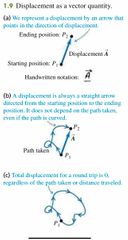
|
|
|
vector addition |
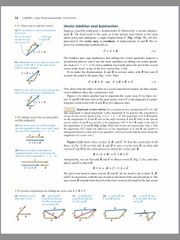
Back (Definition) |
|
|
|
Vector subtraction and multiplication |
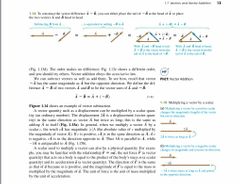
Back (Definition) |
|
|
|
Vector components |
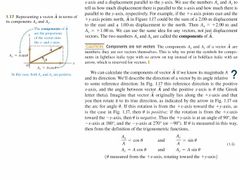
Back (Definition) |
|
|
|
Example 1.6 |
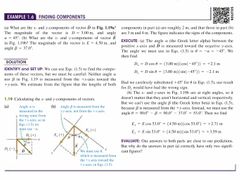
Back (Definition) |
|

